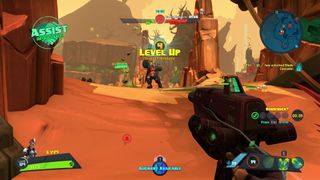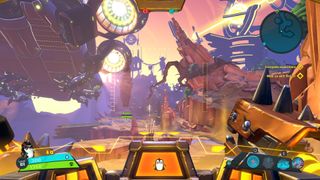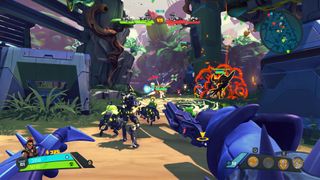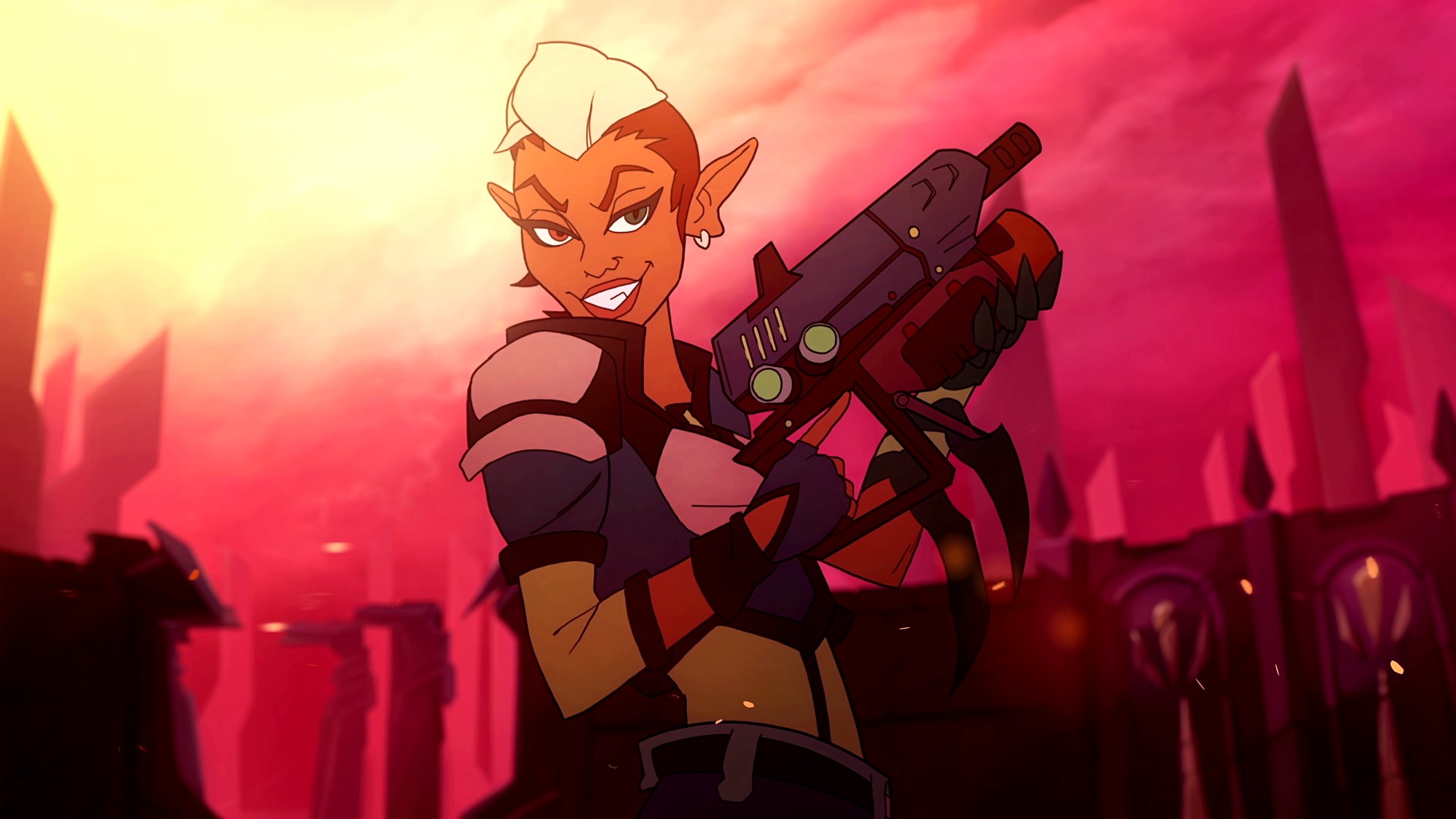Our Verdict
Classic Gearbox shooting with an experimental MOBA twist, but it’s no Borderlands.
PC Gamer's got your back
By Jem Alexander
At first glance, Battleborn looks like more of the same from Gearbox Software. A hyper-stylised, witty adventure with big guns and bigger personalities. But gone is the large, open overworld of the Borderlands games. It’s replaced instead by a small series of replayable story missions in which you and a team of up to four friends and/or strangers shoot monsters, defeat giant bosses and escort sentry robots from point A to B.
Battleborn is not Borderlands 3, though it is very obviously cut from the same mud splattered, studded leather. It feels like an experiment, in many ways, combining the studio’s established co-op shooter heritage with competitive team multiplayer modes. Missions are linear, and you’ll soon become very familiar with where to go and when to shoot as you battle through each half-hour campaign mission. Thankfully the wide character roster and each hero’s varied abilities makes each playthrough feel fresh.
Battleborn has been heavily influenced by MOBAs, that much is obvious. Each hero has two main skills and a powerful ‘ultimate’ skill that is unlocked after gaining a certain amount of experience in each match or mission. The skills themselves range from powerful skillshots (requiring fast reflexes and precise aiming to land) to point-and-click abilities which shield your allies, or set up protective barriers in the environment. Benedict, an anthropomorphised eagle, has an especially satisfying skill which lifts you into the air, allowing you to survey the map before picking an area to crash down onto, dealing damage to enemies in the area. It’s great for jumping into teamfights. Or running away from them. Leveling up also allows you to improve your abilities, giving you a choice between two ‘augmentations’ that could make one of your abilities slow enemies down, increase the amount of damage it deals, or grant you a double jump.

Who's who
Gear is another effective way of customising your heroes. Your loadout contains three items that you’ve found in story mode, or from random gear packs (which can be purchased using Battleborn’s in-game, non-microtransactional credits). These improve your stats, but they need to be activated each game using shards, so farming shards from the environment instead of launching face-first into battle could give you the edge later. That extra 5% attack speed may not sound like a lot, but it could be the difference between winning and losing an important duel.
These layers of strategy borrowed from MOBAs extend to the character select screen. Picking the right team composition will give you a great advantage. It helps that there’s such a wide variety of characters to choose between: 25 in total, with five more coming as DLC over the next few months. Some gun wielders feel like playing a traditional FPS—right click to zoom, left click to fire. Marquis’ pistol is bullet-hungry and requires frequent reloading, but does massive damage if you can land a hit. Whiskey Foxtrot’s burst machine gun, however, rewards shorter range spray-and-pray tactics. FPS fans will be right at home here.
That extra 5% attack speed may not sound like a lot, but it could be the difference between winning and losing an important duel.
On the other hand there are melee heroes like Rath and Boldur, who fight with swords and axes. Having to be close to your enemies means you’re going to be taking damage, but these guys can take a hit or two. Rath’s dual-wielded swords and extreme damage output can feel overpowered if you let him anywhere near you, especially when he activates his Ultimate and transforms into a spinning whirlwind of inescapable death. Boldur’s less likely to kill you than Rath, but you’re going to have a hard time killing him. He’s tanky and his dwarven shield can soak up tons of damage when raised with the right mouse button. He can dole out the damage too, if you’re not careful, but the biggest difficulty with melee characters is keeping the enemy in range. Hopping around Boldur and keeping him disorientated is an annoyingly effective tactic.

The handful of heroes available at the start of the game will soon give you an indication of which play style suits you best. As you unlock more, the roster becomes increasingly more diverse and varied. It’s a testament to Gearbox’s art direction that a science fiction army trooper can stand side by side with a luchador and an elven archer without it being jarring. They all fit together in the gorgeously colourful environments.
It’s the lack of emphasis on the multiplayer, and the strength of the story missions, that surprised me the most. These eight quests are full of the humorous, tongue-in-cheek dialogue that made Borderlands 2 so enjoyable. It’s almost too similar, preventing Battleborn from fully establishing its own identity. The word ‘badass’ gets thrown around a lot and it’s full of sentry robots who believe they’re giant spiders, or over-excited AIs just happy to be out of the house. It’s funny and well written, even if it feels very familiar.
It’s hard not to wonder where the rest of the game is.
The story missions aren’t lengthy, however, and that’s the crux of Battleborn’s issues. It’s hard not to wonder where the rest of the game is. Missions can be played single-player or in a team of up to five and last about half an hour each, for a total of four hours or so. This is not Borderlands 2’s 50 hour campaign, but I replayed these missions often, not least because they’re the best way to test out all of those new heroes I was constantly gaining access to. There are so many unlocks and collectibles in Battleborn that it takes very little effort to be rewarded.

Born identity
Despite an initial feeling that there’s not a lot of game here, the reward loop kept me playing for hours—even after my team’s fourth failed attempt at the penultimate mission, which ends with waves of enemies trying to destroy a frustratingly fragile computer terminal as you attempt to defend it. These horde-mode encounters are easily the worst sections of the story missions, but they’re relatively rare compared to the chaotic skirmishes and large boss battles you encounter as you explore the dungeon-like levels. One mission in particular feels like an actual dungeon, complete with spike traps which the native monsters delight in pushing you towards. Playing as Boldur the dwarf with his throwing axe felt more like playing a fantasy RPG than a sci-fi FPS.
Bouncing back and forth between competitive and cooperative modes makes for a welcome change of pace. Capture Mode PvP matches are a quick, 10-minute chaotic flurry, while Incursion Mode is the real meat of the competitive offering. It’s here that Battleborn wears its MOBA-wannabe heart on its sleeve, as your minions siege your opponents’ base and destroy their sentry robots. It’s League of Legends or Dota 2 boiled down to its most accessible, single-lane format. And as any MOBA fan knows, one lane means plenty of ARAM style chaotic battles as the teams collide.
With Overwatch’s release on the horizon, it’s hard to recommend Battleborn on the strengths of its competitive play alone.
With Overwatch’s release on the horizon, it’s hard to recommend Battleborn on the strengths of its competitive play alone. Overwatch has Battleborn beat in that area, even if the games are different enough to warrant a purchase of both. Overwatch is more newbie friendly and instantly gratifying. It’s a lot easier to feel powerful, whereas Battleborn’s characters and abilities can feel weak and ineffective against other humans. With practice, however, you’ll start to earn your kills as you wrap your head around the skill and character combinations. As such, your strong Battleborn KDA will feel much more rewarding, a characteristic of the MOBA genre the game has truly nailed.
Battleborn feels in the midst of an identity crisis. It's both a safe but enjoyable story game, and seemingly pushing to become the next competitive multiplayer smash. It’s like ordering two starters for dinner. They satiate your hunger, but they’re both different enough that you’d regret only ordering one. Perhaps with all the DLC to come (including five more story missions) one of these modes will be upgraded to a main course.
Classic Gearbox shooting with an experimental MOBA twist, but it’s no Borderlands.
The collective PC Gamer editorial team worked together to write this article. PC Gamer is the global authority on PC games—starting in 1993 with the magazine, and then in 2010 with this website you're currently reading. We have writers across the US, UK and Australia, who you can read about here.

